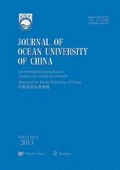Abstract
The catch and effort data of Sillago sihama fishery in Pakistani waters were used to investigate the performance of two closely related stock assessment models: logistic and generalized surplus-production models. Compared with the generalized production model, the logistic model produced more reasonable estimates for parameters such as maximum sustainable yield. The Akaike’s Information Criterion values estimated at 4.265 and −51.152 respectively by the logistic and generalized models. Simulation analyses of the S. sihama fishery showed that the estimated and observed abundance indices for the logistic model were closer than those for the generalized production model. Standardized residuals were distributed closer for logistic model, but exhibited a slightly increasing trend for the generalized model. Statistical outliers were seen in 1989 and 1993 for the logistic model, and in 1981 and 1999 for the generalized model. Simulated results revealed that the logistic estimates were close to the true value for low CVs (coefficients of variation) but widely dispersed for high CVs. In contrast, the generalized model estimates were loose for all CV levels. The estimated production model curve parameter ϕ was not reasonable at all the tested levels of white noise. With the increase in white noise R 2 for the catch per unit effort decreased. Therefore, we conclude that the logistic model performs more reasonably than the generalized production model.
Similar content being viewed by others
References
Efron, B. and Tibshirani, R., 1986. Bootstrap methods for standard errors, confidence intervals, and other measures of statistical accuracy. Statistical Science, 1: 54–75.
Fletcher, R. I., 1978. On the restructuring of the Pella-Tomlinson system. Fishery Bulletin, 76: 515–521.
Fox, W. W., 1975. Fitting the generalized stock production model by least-square and equilibrium approximation. Fishery Bulletin, 73: 23–37.
Haddon, M., 2011. Modeling and Quantities Methods in Fisheries. 2nd edition, CRC Press, Taylor and Francis Group, New York, USA, 449pp.
Hilborn, R. and Walters, C. J., 1992. Quantitative Fisheries Stock Assessment, Choices, Dynamics and Uncertainty. Chapman and Hall, London, UK, 570pp.
Hilborn, R. and Mangel, M., 1997. The ecological detective: confronting models with data. In: Monographs in Population Biology, 28. Levin, S. A. and Horn, H. S. eds., Princeton University Press, Princeton, New Jersey, USA, 318pp.
Jensen, A. L., 2002. Maximum harvest of a fish population that has the smallest impact on population biomass. Fisheries Research, 57: 89–91.
Laloë, F., 1995. Should surplus production models be fishery description tools rather than biological models? Aquatic Living Recourses, 8: 1–16.
Maunder, M. N., Sibert, J. R., Fonteneau, A., Hampton, J., Kleiber, P., and Harley, S. J., 2006. Interpreting catch per unit effort data to assess the status of individual stocks and communities. ICES Journal of Marine Sciences, 63: 1 373–1 385.
Panhwar, S. K., Liu, Q., Khan, F., and Siddiqui, P. J. A., 2012. Maximum sustainable yield estimates of Ladypees, Sillago sihama (Forsskål), fishery in Pakistan, using the ASPIC and CEDA packages. Journal of Ocean University of China, 11(1): 93–98.
Pella, J. J. and Tomlinson, P. K., 1969. A generalized stock production model. Inter-American Tropical Tuna Commission Bulletin, 13: 419–496.
Pitcher, T. J. and Hart, P. J. B., 1982. Fisheries Ecology. Kluwer Academic Publishers, Dordrecht, the Netherlands, 415pp.
Prager, M. H., 1994. A suite of extensions to a non-equilibrium surplus-production model. Fishery Bulletin, 92: 374–389.
Prager, M. H., 2002. Comparison of logistic and generalized surplus-production models applied to swordfish, Xiphias gladius, in the north Atlantic Ocean. Fisheries Research, 58: 41–57.
Prager, M. H., 2005. A stock-production model incorporating covariates (version 5) and auxiliary programs. CCFHR (NOAA) Miami laboratory document MIA-92/93-55, Beaufort Laboratory Document BL-2004-01.
Punt, A. E., 2003. Extending production models to include process error in the population dynamics. Canadian Journal of Fish and Aquatic Sciences, 60: 1217–1228.
Punt, A. E. and Hilborn, R., 1996. Biomass Dynamic Models: User’s Manual. FAO Computerized Information Series (Fisheries), No.10. FAO, Rome, 62pp.
Quinn II, T. J. and Deriso, R. B., 1999. Quantitative Fish Dynamics. Oxford University Press, New York, USA, 542pp.
Ricker, W. E., 1975. Computation and interpretation of biological statistics of fish populations. Bulletin of Fisheries Research Board Canada, 191: 1–382.
Schaefer, M. B., 1957. A study of the dynamics of the fishery for yellowfin tuna in the Eastern Tropical Pacific Ocean. Inter-American Tropical Tuna Commission Bulletin, 2: 247–268.
Schnute, J., 1985. A general theory for the analysis of catch and effort data. Canadian Journal of Fisheries and Aquatic Sciences, 42: 414–429.
Schwarz, G., 1978. Estimating the dimension of a model. Annals of Statistics, 6: 461–464.
Walters, C. J. and Parma, A. M., 1996. Fixed exploitation rate strategies for copying with effects of climate change. Canadian Journal of Fisheries and Aquatic Sciences, 53: 148–158.
Author information
Authors and Affiliations
Corresponding author
Rights and permissions
About this article
Cite this article
Panhwar, S.K., Liu, Q., Amir, S.A. et al. Performance comparison between logistic and generalized surplus-production models applied to the Sillago sihama fishery in Pakistan. J. Ocean Univ. China 11, 401–407 (2012). https://doi.org/10.1007/s11802-012-1930-x
Received:
Revised:
Accepted:
Published:
Issue Date:
DOI: https://doi.org/10.1007/s11802-012-1930-x



